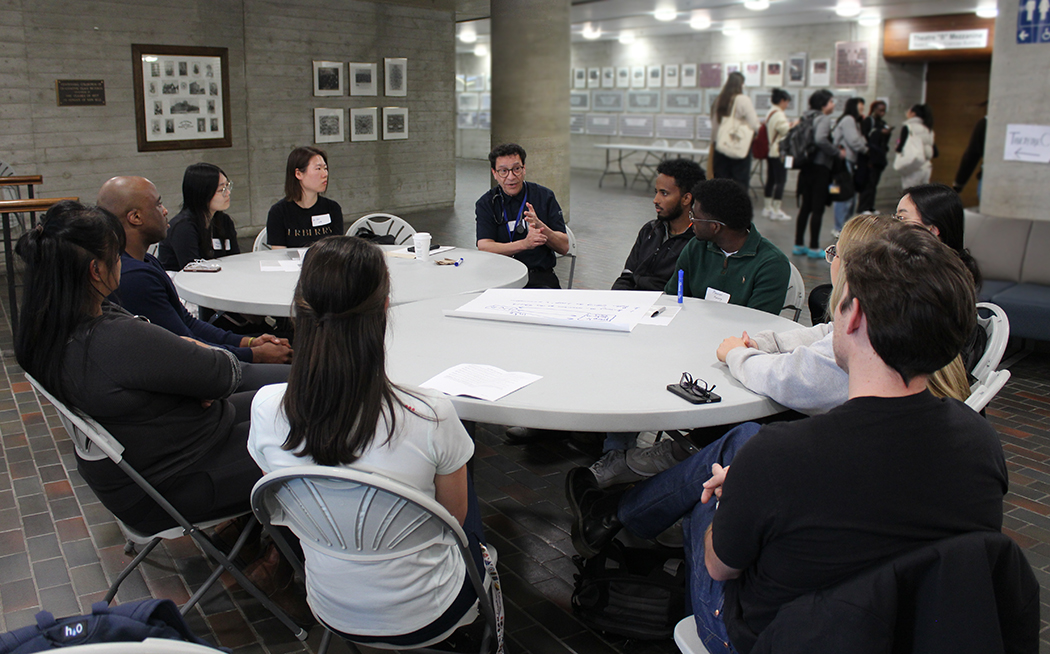
Students worked in interprofessional teams to help save a patient from “falling through the cracks.”
Over 300 health-care students take part in interprofessional workshop, film screening
The Office of Interprofessional Collaboration (OIPC) at the Rady Faculty of Health Sciences held a screening of the film Falling Through the Cracks: Greg’s Story for over 300 students representing multiple health disciplines on Oct 7.
Screened in three theatres on Bannatyne campus, the 2017 film was also shown online for nursing students in The Pas and Thompson, as part of the College of Nursing’s partnership with the University College of the North. In total, 120 medical students took part, along with 130 nursing students, 53 pharmacy students, 13 respiratory therapy students, 11 students from the Faculty of Social Work, and 18 facilitators from each of the represented programs.
The 30-minute film follows the true story of Greg Price, an Alberta man who died at the age of 32 from an undiagnosed blood clot as a complication from testicular cancer. The film was followed by a discussion with Teri Price and Dave Price – Greg’s sister and father – who produced the film with their non-profit organization, Greg’s Wings. Students then broke into interprofessional teams of about 15-18 to discuss how they could have worked as a team to advocate for Greg earlier and help prevent him from “falling through the cracks.”
The last time the Price family screened the film in person at UM was in 2019, but online screenings were held during the pandemic.
Vladan Protudjer, an interim director at OIPC and instructor at the College of Nursing, thought the film and team-based activity would be perfect as an interprofessional exercise, after showing the film to nursing students for the last few years.
“Initially, the film was not made for an interprofessional audience, but rather for medical professionals, residents and medical students, but the family has done over 600 screenings across Canada, and a few in the U.S., and they realized the importance and value of interprofessional collaboration in addressing those gaps in health care,” Protudjer said.
Paul Dubinski, a second-year respiratory therapy student in the College of Rehabilitation Sciences, said it was his first interprofessional collaboration project with nursing and medical students, although he has worked with physical and occupational therapy students in the past.
“It really showed how interprofessional collaboration and communication – or in this case, the lack thereof – can really affect the outcome of a patient,” Dubinski said. “I thought the film was really impactful, especially to have the family there and being completely open to any kind of questions or comments.”
Fourth-year nursing student Jennifer Toews said she found the film very moving, and that it sparked a lot of great discussion around patient safety and record-keeping.
She said one of the highlights was learning about the roles of other disciplines.
“A pharmacy student spoke up and said that pharmacy has a much greater role in people’s health…and that a lot of people will come and talk to their pharmacist before even going to their doctor,” Toews said.
“I know now that when I have a question about medication, I can go straight to pharmacy and they will have the knowledge and we can all work together for the patient’s safety.”
Leah Sullivan, a second-year student in the Max Rady College of Medicine, learned the importance of collaborating as part of an interprofessional health team while working as a bedside nurse for over eight years. She said events like this are vital for students in different health disciplines.
“It just facilitates conversation. If we’re coming in at a baseline, knowing that all of us are here to do the right thing for the patient…it makes all these relationships and interactions so much better, and can really help alleviate some of that hostility and animosity – the “blame game” – that can happen when you’re working in a clinical environment,” she said.
“The film was a really good reminder of how something seemingly very small – like calling a colleague to make sure they got a referral – can make such a huge impact for somebody, and that you are not powerless.”






